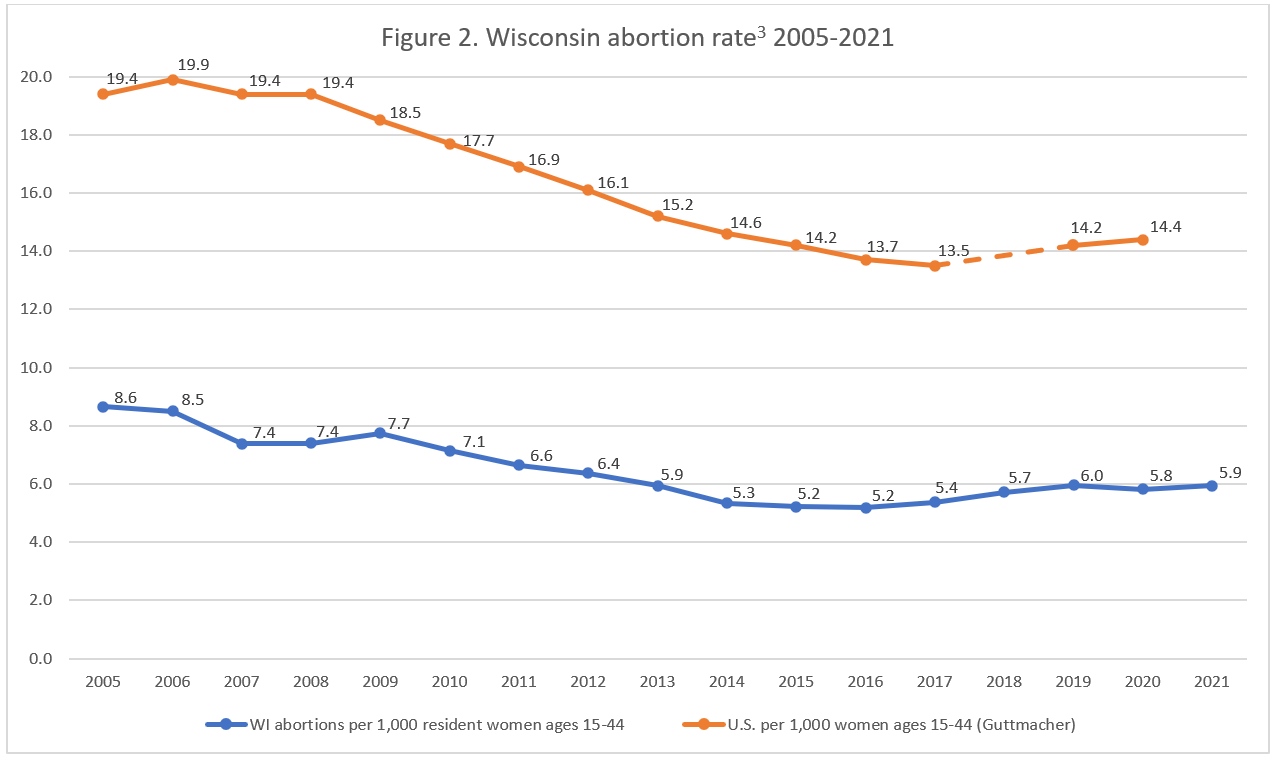Abortion Reporting: Wisconsin (2021)
Wisconsin’s 2021 abortion report was released in October 2022, showing that abortions in Wisconsin increased from 2020.
Statistics and Changes in Wisconsin Abortions, 2020-2021

The change in total abortions and chemical abortions reflects abortions performed on Wisconsin residents. The change in the abortion rate reflects all abortions reported in Wisconsin, including those obtained by non-residents. The report does not include information on Planned Parenthood’s Wisconsin abortion market share.
Abortion Totals and Trends
Wisconsin reported 6,579 abortions in 2021, up two percent from the year before. Of these, 6,472 were performed on Wisconsin residents, including 2,486 chemical abortions (Fig. 1). Chemical abortions performed on Wisconsin residents increased by less than one percent, making up 38 percent of Wisconsin resident abortions in 2021. The Charlotte Lozier Institute (CLI) estimates that Wisconsin’s abortion rate increased by two percent from 2020 to 5.9 abortions per 1,000 women ages 15 to 44 (Fig. 2). As of November 2022, 24 states had released 2021 abortion statistics; 17 of these states reported that abortions had increased.
State Report Summary
In 2021, 98 percent of the abortions occurring in Wisconsin were performed on Wisconsin residents, while two percent were obtained by nonresident women. Three percent of the abortions were on girls under the age of 18, and seven percent were on girls aged 18 to 19. Thirty percent were performed on women ages 20 to 24, 28 percent were performed on women ages 25 to 29, and another 28 percent were performed on women in their thirties. Three percent were performed on women aged 40 or older.
There were 214 abortions performed on Wisconsin residents under the age of 18. Five were emancipated minors. Twenty-three minors obtained judicial waivers of Wisconsin’s parental consent requirement, and 186 minors had adults provide consent on their behalf. Of these 186 cases, 167 had consent provided by a parent and 19 had consent provided by a different family member.
Just over half the abortions, 52 percent, were on white women. Thirty-five percent were performed on black women, and three percent were on women of Asian or Pacific Islander descent. One percent of the abortions were on Native American women, and two percent were on women with multiple races. Two percent were obtained by women of other races, and four percent were on women of unknown races. Eighty-five percent of the abortions were on non-Hispanic women, 14 percent were on Hispanic women, and not quite one percent were on women of unreported ethnicity. CLI estimates that the black abortion rate, 25.6 abortions per 1,000 women ages 15 to 44, was seven times higher than the white abortion rate of 3.7.
Eighty-eight percent, a large majority, of the abortions were on unmarried women, 12 percent were on married women, and less than one percent were on women of unknown marital status. Nine percent of the abortions were on women who had not graduated from high school. Forty-six percent were on women with a high school diploma or GED, and 31 percent were on women had attended some college or who had an associate’s degree. Fourteen percent were performed on women with a bachelor’s degree or more. Level of education was not reported for one percent.
More than half the abortions (59 percent) occurred at eight weeks of gestation or earlier. Twenty percent were performed between nine and 10 weeks, and nine percent occurred from 11 to 12 weeks of gestation. Six percent were performed from 13 to 15 weeks, and another six percent from 16 to 20 weeks of gestation. There were 42 abortions, almost one percent, performed after 20 weeks of gestation. Unless in cases of medical emergency, abortion in Wisconsin in 2021 was limited at 20 weeks post-fertilization, around 22 weeks of gestation. The report cautions that gestational age data can be inconsistent and imprecise; some providers report the length of pregnancy from the woman’s last menstrual period (LMP), while others provide an estimate of gestational age.
Information on the types of abortion procedures is provided for abortions performed on Wisconsin residents only. Of the abortions performed on Wisconsin women, 61 percent were performed using surgical procedures, and 38 percent were chemical abortions. In addition, there were 17 failed or incomplete chemical abortions that were completed surgically. The Wisconsin Department of Health Services told CLI that there is no way of determining whether any of these incomplete abortions were also included in the total count of chemical abortions. If these incomplete chemical abortions were double counted, they would slightly inflate Wisconsin’s 2021 abortion total and rates.
In 2021, 91 percent of the abortions were reported to have no complications.1 Multiple complications can be reported for each abortion, and the most frequently reported complication was retained products of conception, occurring 39 times. Hemorrhage occurred nine times. There were three infections and one case of a uterine perforation. Additionally, there were 567 other, unspecified complications. The report acknowledges the possibility that “some complications are missed or misreported.”
State Ranking
In 2016, CLI evaluated abortion reporting in the 50 states as well as New York City and the District of Columbia. Wisconsin’s reporting was tied for 17th best. To improve its reporting, Wisconsin could report the types of surgical abortion procedures with more specificity and report the types of procedures for all abortions that occurred in the state, not just the ones obtained by resident women. Wisconsin could also indicate whether complications stemmed from chemical or surgical abortions. In addition, Wisconsin could amend its abortion reporting form to allow providers to indicate whether they reported weeks LMP or estimated the length of the pregnancy.


- Statistics on abortion complications reported here represent a minimal number of deaths and complications, as this data is collected in a non-systematic and non-verifiable way. As such, this data cannot be used to calculate either an accurate abortion mortality rate or an accurate abortion complication rate for the state. The report cautions that “Assessing the incidence of complications is somewhat difficult Some complications do not occur immediately or become apparent while the patient is in post-procedure recovery, therefore, some complications are missed or misreported.”
- Because the Wisconsin Department of Health Services is unable to tell whether an incomplete chemical abortion was previously reported as a chemical abortion, CLI is unable to determine if these incomplete abortions are included in the chemical abortion totals.
- Rates were calculated by CLI using the following formula: (total number of abortions performed in Wisconsin ÷ number of resident women ages 15-44) x 1,000. Rates may differ slightly from previous CLI articles due to revised population estimates. Population estimates were obtained from the CDC WONDER database. Estimates for 2005-2009 are intercensal estimates of the July 1 resident population. Estimates for 2010-2019 are Vintage 2020 postcensal estimates of the July 1 resident population. Estimates for 2020-2021 are Vintage 2021 postcensal estimates of the July 1 resident population. Estimates were produced by the U.S. Census Bureau and the National Center for Health Statistics.



























